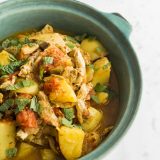Exploring Cape Town’s Bo-Kaap neighborhood is an exercise in sensory overload.
First, there is the fluorescence of the homes, long rows of bright pastel yellows, greens, blues, purples and pinks, together weaving an electric tapestry.
Next come waves of spices emanating from open doors and windows, as well as the many spice markets, where puzzlingly named blends—Father-in-law curry? Leaf masala?—crowd shelves.
Finally, a history impossible to shake the weight of. For these streets, tucked tight to the soaring slopes of Signal Mountain, make up the city’s oldest neighborhood, built by a globe-spanning collection of slaves, exiles and prisoners.
And somehow one local dish manages to capture all of that.
Cape Malay curry, a chicken and vegetable one-pot, from a distance reads Indian, or maybe Indonesian. But get closer and Cape Malay distinguishes itself as uniquely South African. Similar ingredients are used differently, producing a lighter, brighter, more mild—yet still alluringly aromatic—curry than those most of us know.
My close-up is with Faldela Tolker, who teaches Cape Malay cuisine in the bare kitchen of her purple Bo-Kaap home. At her table, as seemingly random children run in and out, I take a bite.
Vivid, distinct flavors that permeate rather than coat potatoes and tender bites of chicken. It lacks the heft of Indian curries. Refreshingly so. It’s at once lemony and richly savory, the colors and flavors as bright as the homes.
“Cape Malay cooking is a fusion. Indian. Malaysian. Madagascar. European,” Tolker says. “The spices are the same, but they are used differently.”
Cooking Curry in Cape Malay
Faldela Tolker teaches Cape Malay cuisine at her purple home in Bo-Kaap.
To illustrate her point, she walks me through the recipe, grabbing a round plate-sized tin holding multiple spices. Curry leaves, cinnamon, cardamom, fennel and coriander. A conventional lineup.
Except all of them are whole. And they stay that way, added to a brothy mixture to simmer. They smell clean and distinct, savory notes of cinnamon and peppery anise. Most are discarded just before serving, their job complete.
I begin to understand the difference. In many South Asian recipes, spices are often toasted and ground, a process that deepens their flavors and thickens the sauces to which they are added, all in bold, heavier strokes.
Cape Malay cooking favors lighter and simpler. Which is to say, Cape Malay is to Indian curry as a thin-Chicago deep dish.
The cuisine is rooted in South Africa’s colonial history. The neighborhood was settled in the 1650s mostly by Muslim slaves and convicts from India, Indonesia and Sri Lanka, generally against their will.
In the coming centuries, its diversity exploded. Until apartheid. In 1950, it was designated a Muslim-only community. All others were expelled, cementing an identity that persists today.
Along that journey, the food adapted and changed with waves of immigrants. But at every turn, it remained a steadfastly working-class neighborhood. And that defined how its people cooked.
Efficiency nudged out nuance. Just get everything in the pot and move on. It’s a philosophy we can relate to at Milk Street.
And while we love South Asian cooking, the bright simplicity of Cape Malay curry spoke to us.
Cooking with ground spices gives food more spunk, but maybe more funk, too. Grinding whole spices releases aromatic compounds, which contribute bigger, bolder flavors. But it also exposes them to oxidation, which can muddy their flavor depending on how they are used. When spices are left whole, those compounds stay fresher longer. Cooking with them contributes less—but cleaner, brighter—flavor.




